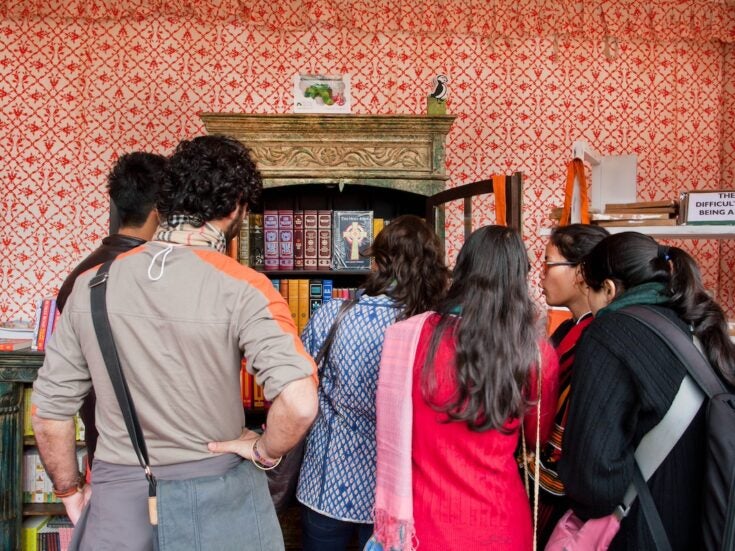
They Don’t Make ‘Em Like They Used To
Nicole Swengley on the multi-layered possibilities of ‘additive manufacturing’, the astonishing 3D printing process that is literally transforming the world of design
ANYONE STROLLING THROUGH the Chinoiserie area of the V&A’s British Galleries during the London Design Festival last autumn might have been forgiven for doing a double-take. For there among the 18th-century vases, chairs and mirrors was a thoroughly modern lamp. Its decorative shape referenced the lotus flower forms of surrounding historical designs, but its material — white nylon — clearly marked it out as a contemporary ‘intervention’, deliberately positioned to surprise and enchant visitors to the gallery.
Like an exotic bloom, the lamp’s elegant shade could be opened and closed to diffuse less or more light. This articulation was not, however, the only clever thing about it. Designer Patrick Jouin’s Bloom light (pictured above, left) was created via the cutting-edge technology known as additive manufacturing, in which objects are ‘printed’ three-dimensionally, complete with all their moving, mechanical parts — a phenomenon unique to 3D printing processes.
Is this the shape of things to come? The New York gallerist Murray Moss believes so. ‘Additive manufacturing will define an absolutely new way of making things in the future,’ he says. It’s a view shared by British designer Michael Eden, whose latest 3D-printed vessels will be unveiled by Adrian Sassoon’s gallery at forthcoming shows including TEFAF in Maastricht (March) and both Collect (May) and Masterpiece (June/July) in London. ‘We’re on the brink of a new industrial revolution that will change the way we think about every object around us,’ says Eden.

The 3D printing process belongs to a group of rapid-manufacturing technologies that employ software packages to translate designs created as computer files into objects that are printed ‘in the round’ by a machine. Products — from furniture to lighting, jewellery to shoes — are built up, layer by layer, and fabricated as complete units so that no assembly is required.
The technology embraces various techniques. Some, like 3D printing, use computer-controlled glue-guns to build up objects from fine layers of epoxy. Others employ infrared lasers to create a solid form from a liquid such as resin (stereolithography) or from layers of fine powder ranging from nylon to titanium (selective laser sintering). A good introduction to the technology can be found at the exhibition ‘Send to Print/Print to Send’ at London’s Aram Gallery (until 25 February).
‘It opens up completely new opportunities,’ says designer Assa Ashuach, whose Fly (£4,000), AI (£35,000) and Omi (£1,700) lights, produced by this process, are available from Rabih Hage Gallery in London. Eden agrees: ‘You have complete freedom in terms of form and it allows me to make impossible objects that couldn’t be made in any other way.’ He cites his Wedgwoodn’t Tureen (from £7,500 at Adrian Sassoon Gallery) — a contemporary twist on a traditional form ‘printed’ in nylon with a mineral soft coating (pictured below, left).
Taking the technology a step further, Eden has incorporated QR (quick response) codes into several designs. The QR codes integrated within the form of his Viniculum vessel (from £8,500), shown at the Cheongju International Craft Biennale last November, and on top of his Babel vessel (£7,000) connect anyone scanning the pieces with a smartphone barcode-reader app to a web page detailing the inspiration behind the designs. Similarly, when smartphone users scan Eden’s 3D-printed Mnemosyne box (£5,000) they’re linked to a website where memories can be stored and sounds locked away — in effect a virtual keepsake box.

Interior decorators relish 3D printing for its ability to produce bespoke, site-specific creations at speed. Staffan Tollgard, a London-based interior designer, recently installed an exotic palm chandelier, custom-made by the Amsterdam-based Freedom of Creation, in the living room of a Grade II listed private house in London. ‘The decision was driven by aesthetics,’ he says. ‘It’s a high-impact design that’s beautifully sculptural and looks amazing when lit or unlit. And the process by which it’s made is fascinating.’
COLLECTORS, TOO, ARE increasingly attracted to one-off or limited-edition designs produced by this process. ‘What held such appeal for me is that an object with such a pleasing, aesthetic sensibility could be created not in a traditional fashion employed for hundreds of years, but in such a hi-tech, unimaginable manner,’ says Chris Zois, a New York-based screenwriter who purchased a BigBlackHoney fruit bowl by designer Arik Levy as a gift for a friend.
The merits of acquiring key, early examples of additive manufacturing have not gone unnoticed by collectors. When Murray Moss introduced Patrick Jouin’s SOLID collection at Design Miami in 2005, the three designs were im mediately snapped up. Moss now sells editions of the S1 stool (originally $18,000) for $28,000, while the C2 chair and T1 table (respectively $24,000 and $22,000 in 2005) currently cost $38,000 each.
Not every design, however, is a museum must-have. As Jana Scholze, curator for modern furniture and product design at the V&A, points out: ‘An object has to be important for design history in terms of new material, technique or social impact [to be worth acquiring].’
The V&A’s first 3D-printed acquisition was the Fractal.MGX table, designed by Gernot Oberfell and Jan Wertel with Matthias Bär, which featured in a show curated by Murray Moss during the London Design Festival last September. The museum has also purchased Patrick Jouin’s OneShot.MGX folding stool — the first object ever to be printed fully articulated. Initially produced in 2006 by the Belgian additive-manufacturing specialist Materialise, in laser-sintered nylon, it has also been acquired by New York’s Museum of Modern Art, Centre Pompidou in Paris and the Art Institute of Chicago. Editions of the design can be purchased for $3,200 at Moss, which also stocks Jouin’s Bloom light ($3,600).
Not all 3D-printed objects cut the curatorial mustard. ‘We’re looking for designs that push the capabilities of the manufacturing processes,’ says Zoe Ryan, chair and John H Bryan curator of architecture and design at the Art Institute of Chicago. ‘Rather than glorifying technology, the most innovative designs are those that use new technologies in the service of qualitatively different objects that go beyond previously realised designs and offer new ways of engaging with — and understanding — the world.’

Collectors need to tread with care, as even the rarefied arena of limited editions can be undermined by over-supply. Unlike conventional manufacturing, which requires individual moulds and tooling, 3D printers respond to computer programmes, so it’s no more expensive or laborious to create 100 different objects than 100 identical ones. Ensuring that a design really is a one-off or a limited edition could thus become increasingly tricky as the technology develops.
MEANWHILE, LISA ROBERTS, the Philadelphia-based author of Antiques of the Future, aims to collect ‘key, iconic, contemporary designs that are good representations of new processes and materials’. So Jouin’s OneShot stool and Bloom lamp, Marcel Wanders’ Snotty vase and François Brument’s Vase#44 are among her carefully selected examples of 3D printing.
‘I think it’s the way of the future,’ she says. ‘Additive manufacturing is in its infancy but is changing very fast. The designs are becoming more elaborate and materials are changing, too. Originally the technology was just for prototyping — initially using polyamide or nylon — but as materials have become more refined it has become a process of manufacture. We’re now seeing designs in metal and I’m waiting for ceramics and glass to come next.’
Roberts, who is a trustee at the Philadelphia Museum of Art and the Cooper-Hewitt National Design Museum, believes the technology offers scope for more emotive pieces. ‘Jouin said of his Bloom lamp that he was able to design the “gesture” — the way the flower opens up. As it moves from a smooth, concise, graphic shape into the open, complex form of a flower you see the design going through a transformational process that Jouin said would have been impossible to make in any other way.
‘I believe 3D printing is going to impact manufacturing in a huge way because of the potential for customisation,’ she adds. ‘Everyone will be able to get exactly what they want. And, instead of waiting weeks for a chair to be made and delivered, you’ll be able to download a computer file and have it produced at a local 3D printing centre. Really, we’re on the cusp of the next industrial revolution.’
Nicole Swengley is a design writer who contributes to the FT and other publications
Light photograph by Thomas Duval. Tureen courtesy of Adrian Sassoon.







